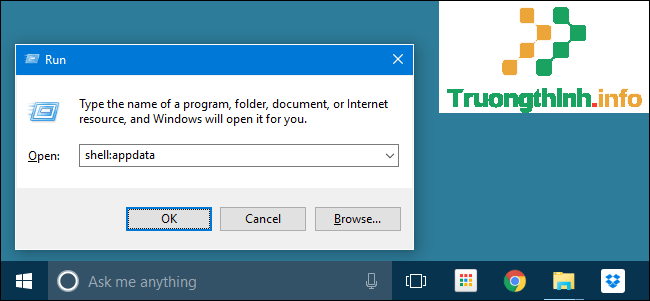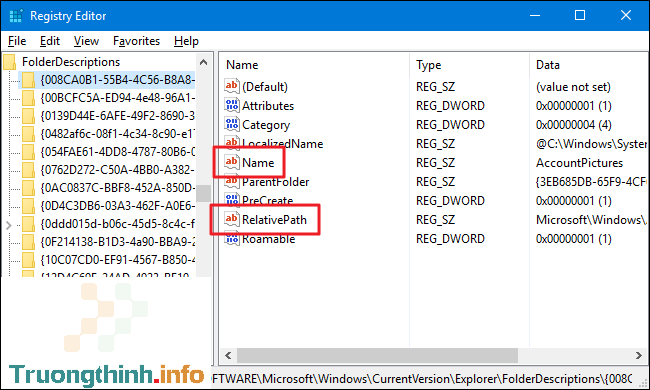Chưa có sản phẩm trong giỏ hàng.
FAQs Máy Tính
Làm thế nào để mở các thư mục ẩn trên hệ thống bằng lệnh Shell trên Windows? – Sửa lỗi máy tính
Web Trường Thịnh Group có bài: Làm thế nào để mở các thư mục ẩn trên hệ thống bằng lệnh Shell trên Windows? – Sửa lỗi máy tính Trên hệ điều hành có rất nhiều thư mục hệ thống ẩn có thể nhận dạng được trên Windows Registry bằng key CLSID, tên thư mục cụ thể và vị trí thư mục trên máy tính của bạn.
Hotline: 1900 63.63.43
☎ 0287300 7898 – 0938 169 138 (Zalo) 0984.966.552 (Zalo)
Trên hệ điều hành có biết bao thư mục hệ thống ẩn có thể “nhận dạng” được trên Windows Registry bằng key CLSID, tên thư mục cụ thể và vị trí thư mục trên máy tính của bạn.
Ngoài ra khi dùng phối hợp tên các thư mục cụ thể cùng lệnh Shell cùng nghĩa với việc các thư mục ẩn dù có bị “chôn sâu” trên hệ thống thì cũng sẽ bị “đào” lên.

1. Key CLSID là gì?
Vị trí các thư mục cụ thể (và một số ứng dụng khác) được cung cấp một CLSID cho phép Windows và các chương trình khác cũng có thể có thể đơn giản “nhận diện” các thư mục mà chẳng càng phải biết chính xác tên thư mục đó.
Key CLSID, tên gọi chung và đường dẫn đầy đặn được dùng để lưu giữ các thư mục này giống như các thư mục trên Windows Registry.
Bản chất của nó tương tự như cách mà mỗi máy tính trên hệ thống mạng của bạn đều có 1 tên cụ thể để bạn cũng có thể có thể dễ dàng nhớ được – khi bạn sử dụng tên máy tính (computer name), Windows sẽ tra địa chỉ IP của máy tính cho bạn.
Trong và một cách, các chương trình có thể sử dụng một tên chung (command name) cho 1 thư mục trên cấu trúc của Windows và dựa vào vị trí ngày nay của thư mục được lưu giữ để tạo một key CLSID trên Registry.
Shell sẽ khiến việc cùng các thư mục được liệt kê trong Regitry tại vị trí:
HKEY_LOCAL_MACHINESOFTWAREMicrosoftWindowsCurrentVersionExplorerFolderDescriptions

Mỗi một subkey trong danh sách key FolderDescriptions đại diện cho 1 thư mục cụ thể. Tên của mỗi key là CLSID của thư mục đó. Khi bạn click vào bất kỳ một subkey nào tại đó, bạn sẽ nhìn thấy một số value quan trọng đính kèm với key đó, chẳng hạn như Name (tên chung cả của thư mục) và RelativePath (đường dẫn ngày nay nơi thư mục được lưu trữ).
2. Sử dụng lệnh Shell như thế nào?
Để mở một thư mục, bạn có thể sử dụng một lệnh Shell cụ thể cùng tên một thư mục đó.
Bạn có thể sử dụng lệnh Shell từ hộp thoại Run (nhấn tổ hợp phím Windows + R), trên thanh địa điểm Windows File Explorer và sẽ cho dù là trên cả thanh địa chỉ Internet Explorer. Chỉ cần nhập lệnh theo cú pháp lệnh dưới đây:
shell:
Ví dụ nếu bạn mong muốn mở thư mục có chứa hình ảnh được dùng để làm tạo tài khoản Windows của bạn, thay vì duyệt tìm trong thư mục AppData trên tài khoản của bạn, bạn chỉ cần mở cửa sổ lệnh Run, nhập câu lệnh dưới đây vào rồi nhấn Enter là xong:
shell:AccountPictures

3. Tên các thư mục có sẵn
Dưới đây là danh sách tên các thư mục bạn cũng có thể có thể sử dụng sau lệnh Shell và địa thế kha khá của các thư mục:
shell:AccountPictures – %AppData%MicrosoftWindowsAccountPictures
shell:AddNewProgramsFolder – Control PanelAll Control Panel ItemsGet Programs
shell:Administrative Tools – %AppData%MicrosoftWindowsStart MenuProgramsAdministrative Tools
shell:AppData – %AppData%
shell:Application Shortcuts – %LocalAppData%MicrosoftWindowsApplication Shortcuts
shell:AppsFolder – Applications
shell:AppUpdatesFolder – Installed Updates
shell:Cache – %LocalAppData%MicrosoftWindowsINetCache
shell:Camera Roll – %UserProfile%PicturesCamera Roll
shell:CD Burning – %LocalAppData%MicrosoftWindowsBurnBurn
shell:ChangeRemoveProgramsFolder – Control PanelAll Control Panel ItemsPrograms and Features
shell:Common Administrative Tools – %ProgramData%MicrosoftWindowsStart MenuProgramsAdministrative Tools
shell:Common AppData – %ProgramData%
shell:Common Desktop – %Public%Desktop
shell:Common Documents – %Public%Documents
shell:CommonDownloads – %Public%Downloads
shell:CommonMusic – %Public%Music
shell:CommonPictures – %Public%Pictures
shell:Common Programs – %ProgramData%MicrosoftWindowsStart MenuPrograms
shell:CommonRingtones – %ProgramData%MicrosoftWindowsRingtones
shell:Common Start Menu – %ProgramData%MicrosoftWindowsStart MenuProgramsStartup
shell:Common Startup – %ProgramData%MicrosoftWindowsStart MenuProgramsStartup
shell:Common Templates – %ProgramData%MicrosoftWindowsTemplates
shell:CommonVideo – %Public%Videos
shell:ConflictFolder – Control PanelAll Control Panel ItemsSync CenterConflicts
shell:ConnectionsFolder – Control PanelAll Control Panel ItemsNetwork Connections
shell:Contacts – %UserProfile%Contacts
shell:ControlPanelFolder – Control PanelAll Control Panel Items
shell:Cookies – %LocalAppData%MicrosoftWindowsINetCookies
shell:CookiesLow – %LocalAppData%MicrosoftWindowsINetCookiesLow
shell:CredentialManager – %AppData%MicrosoftCredentials
shell:CryptoKeys – %AppData%MicrosoftCrypto
shell:desktop – Desktop
shell:device Metadata Store – %ProgramData%MicrosoftWindowsDeviceMetadataStore
shell:documentsLibrary – LibrariesDocuments
shell:downloads – %UserProfile%Downloads
shell:dpapiKeys – %AppData%MicrosoftProtect
shell:Favorites – %UserProfile%Favorites
shell:Fonts – %WinDir%Fonts
shell:Games – Games
shell:GameTasks – %LocalAppData%MicrosoftWindowsGameExplorer
shell:History – %LocalAppData%MicrosoftWindowsHistory
shell:HomeGroupCurrentUserFolder – Homegroup(user-name)
shell:HomeGroupFolder – Homegroup
shell:ImplicitAppShortcuts – %AppData%MicrosoftInternet ExplorerQuick LaunchUser PinnedImplicitAppShortcuts
shell:InternetFolder – Internet Explorer
shell:Libraries – Libraries
shell:Links – %UserProfile%Links
shell:Local AppData – %LocalAppData%
shell:LocalAppDataLow – %UserProfile%AppDataLocalLow
shell:MusicLibrary – LibrariesMusic
shell:MyComputerFolder – This PC
shell:My Music – %UserProfile%Music
shell:My Pictures – %UserProfile%Pictures
shell:My Video – %UserProfile%Videos
shell:NetHood – %AppData%MicrosoftWindowsNetwork Shortcuts
shell:NetworkPlacesFolder – Network
shell:OneDrive – OneDrive
shell:OneDriveCameraRoll – %UserProfile%OneDrivePicturesCamera Roll
shell:OneDriveDocuments – %UserProfile%OneDriveDocuments
shell:OneDriveMusic – %UserProfile%OneDriveMusic
shell:OneDrivePictures – %UserProfile%OneDrivePictures
shell:Personal – %UserProfile%Documents
shell:PicturesLibrary – LibrariesPictures
shell:PrintersFolder – All Control Panel ItemsPrinters
shell:PrintHood – %AppData%MicrosoftWindowsPrinter Shortcuts
shell:Profile – %UserProfile%
shell:ProgramFiles – %ProgramFiles%
shell:ProgramFilesCommon – %ProgramFiles%Common Files
shell:ProgramFilesCommonX64 – %ProgramFiles%Common Files (64-bit Windows only)
shell:ProgramFilesCommonX86 – %ProgramFiles(x86)%Common Files (64-bit Windows only)
shell:ProgramFilesX64 – %ProgramFiles% (64-bit Windows only)
shell:ProgramFilesX86 – %ProgramFiles(x86)% (64-bit Windows only)
shell:Programs – %AppData%MicrosoftWindowsStart MenuPrograms
shell:Public – %Public%
shell:PublicAccountPictures – %Public%AccountPictures
shell:PublicGameTasks – %ProgramData%MicrosoftWindowsGameExplorer
shell:PublicLibraries – %Public%Libraries
shell:Quick Launch – %AppData%MicrosoftInternet ExplorerQuick Launch
shell:Recent – %AppData%MicrosoftWindowsRecent
shell:RecordedTVLibrary – LibrariesRecorded TV
shell:RecycleBinFolder – Recycle Bin
shell:ResourceDir – %WinDir%Resources
shell:Ringtones – %ProgramData%MicrosoftWindowsRingtones
shell:Roamed Tile Images – %LocalAppData%MicrosoftWindowsRoamedTileImages
shell:Roaming Tiles – %AppData%MicrosoftWindowsRoamingTiles
shell:SavedGames – %UserProfile%Saved Games
shell:Screenshots – %UserProfile%PicturesScreenshots
shell:Searches – %UserProfile%Searches
shell:SearchHistoryFolder – %LocalAppData%MicrosoftWindowsConnectedSearchHistory
shell:SearchHomeFolder – search-ms:
shell:SearchTemplatesFolder – %LocalAppData%MicrosoftWindowsConnectedSearchTemplates
shell:SendTo – %AppData%MicrosoftWindowsSendTo
shell:Start Menu – %AppData%MicrosoftWindowsStart Menu
shell:StartMenuAllPrograms – StartMenuAllPrograms
shell:Startup – %AppData%MicrosoftWindowsStart MenuProgramsStartup
shell:SyncCenterFolder – Control PanelAll Control Panel ItemsSync Center
shell:SyncResultsFolder – Control PanelAll Control Panel ItemsSync CenterSync Results
shell:SyncSetupFolder – Control PanelAll Control Panel ItemsSync CenterSync Setup
shell:System – %WinDir%System32
shell:SystemCertificates – %AppData%MicrosoftSystemCertificates
shell:SystemX86 – %WinDir%SysWOW64
shell:Templates – %AppData%MicrosoftWindowsTemplates
shell:ThisPCDesktopFolder – Desktop
shell:UsersFilesFolder – %UserProfile%
shell:User Pinned – %AppData%MicrosoftInternet ExplorerQuick LaunchUser Pinned
shell:UserProfiles – %HomeDrive%Users
shell:UserProgramFiles – %LocalAppData%Programs
shell:UserProgramFilesCommon – %LocalAppData%ProgramsCommon
shell:UsersLibrariesFolder – Libraries
shell:VideosLibrary – LibrariesVideos
shell:Windows – %WinDir%
Tham khảo thêm 1 số bài viết dưới đây:
- Sử dụng lệnh CMD để loại bỏ virus trên máy tính Windows
- Sử dụng Command Prompt để quản lý mạng không dây trên Windows 10 như làm sao?
- Làm thế nào để kích hoạt Ctrl+C/Ctrl+V để thực hiện lệnh dán trong cửa sổ Command Prompt?
Chúc các bạn thành công!
Xem thêm: vệ sinh máy tính tại nhà vs dịch vụ sửa internet tại nhà hcm vs
- Hướng dẫn 5 cách xóa tài khoản User trên Windows 10
- Đổi màu tên tập tin hoặc thư mục bất kỳ trong Windows
- 34 phím tắt cmd (Command Prompt) thông dụng trên Windows
- Hướng dẫn sửa lỗi “Cannot delete folder: The directory is not empty”
- Quản lý màn hình Desktop gọn hơn với Fences
- Sử dụng Command Prompt để thêm hoặc xóa tài khoản User
lệnh shell, mở thư mục ẩn trên windows, sử dụng lệnh shell mở thư mục ẩn, shell command, mở file ẩn trên windows, thư mục ẩn trên windows, key CLSI, lệnh shell
Nội dung Làm thế nào để mở các thư mục ẩn trên hệ thống bằng lệnh Shell trên Windows? – Sửa lỗi máy tính được tổng hợp sưu tầm biên tập bởi: Trường Thịnh Group. Mọi ý kiến vui lòng gửi Liên Hệ cho truongthinh.info để điều chỉnh. truongthinh.info tks.
